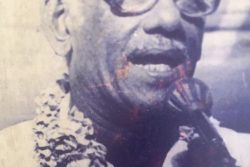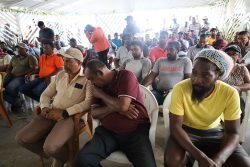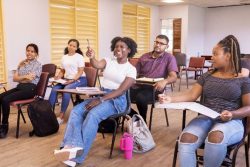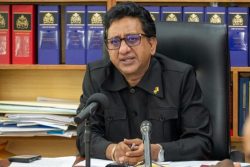Stanley Greaves: Linking Stabroek Square (the former slave market) and Independence Square is Brickdam (built with bricks and named Longchamps during the French Occupation). This sequence marks the journey between the first strike for independence by Cuffy (Kofi) in 1763 and Guyana’s independence in 1966. It is fitting, therefore, to pay some attention and respect to the 1763 Monument by Philip Moore.
Akima McPherson: Fitting too as it was unveiled during the month of May 1976. And as the nation celebrates, and some commemorate, 50 years the 1763 Monument turns 40 and the ideas it encapsulates in its layers of symbolism remain timeless. Unfortunately, because of this layering of symbolism the 1763 Monument is not understood by many Guyanese. I think the non-western aesthetic it embraces requires a point of reference for people whose aesthetic has been Westernised3.
SG: I see Philip Moore as a mystic who reveals his vision through a highly personal symbolism that has no reference to western concepts. This creates problems, as the 1763 Monument did for a general public, especially one not educated in the language of the visual arts. As the late Director of Art Denis Williams said, it is certainly one of the most striking public monuments anywhere in the Caribbean. It was actually the idea of the late Martin Carter when he was Minister of Culture. Karl Broodhagen, Guyanese born sculptor living in Barbados, was asked to design a monument. His design was not accepted I suspect due to its realism, and it is now the Bussa Monument in Barbados. That monument honours a slave revolt leader like Cuffy, on the island. It was Williams who took up the idea of a monument and Moore won the competition.
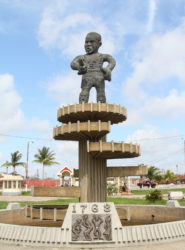
Philip Moore
Bronze
1975-1976
Square of the Revolution
Unveiled on Sunday 23 May, 1976
AM: With statements like, “Man is an ancient soul in a modern body,” and references to dreams in his own development in art indeed I see how the word ‘mystic’ can be applied. Moore’s rich wisdom needs decoding. A lot of it is found in his art, but as it is not mainstream and at times it is syncretic; it is hard for most to understand the work. This coupled with his frequent use of personal symbolism makes his body of work a challenge. As a child, I was terrified of the 1763 Monument. Once I understood the proportion system used for the figure I began to appreciate it. West African traditional principles hold that the head is the centre of man’s existence on multiple levels. Hence it is enlarged in human figurative sculpture to reflect the importance ascribed to that aspect of the body. Moore used an approximate 1:3 ratio for the head to the body. Within the figure’s gestures and objects in hand are personal symbols of resistance, ignorance, greed and lust. The many faces on the body reference leaders of slave revolts and of the independence struggle.
SG: I am not sure that Moore based his proportions in the figure on the mathematical principles you quote. It is easy to recognise those proportions looking at African sculptures. In the end, the viewer has to use whatever information is available along with personal experiences and readings about art to create their own appreciation. Moore’s work in general is atavistic (rebirth of ancestral spiritual culture) to a great degree because of his connection to West African culture. His position is not based on intellectual considerations or current beliefs but on personal spiritual visions: “I am an ancient African mind in a modern body.” I did write at length about Moore as a spiritualist primarily, in The Arts Journal, September 2012 Vol: 8 #1 & 2.


